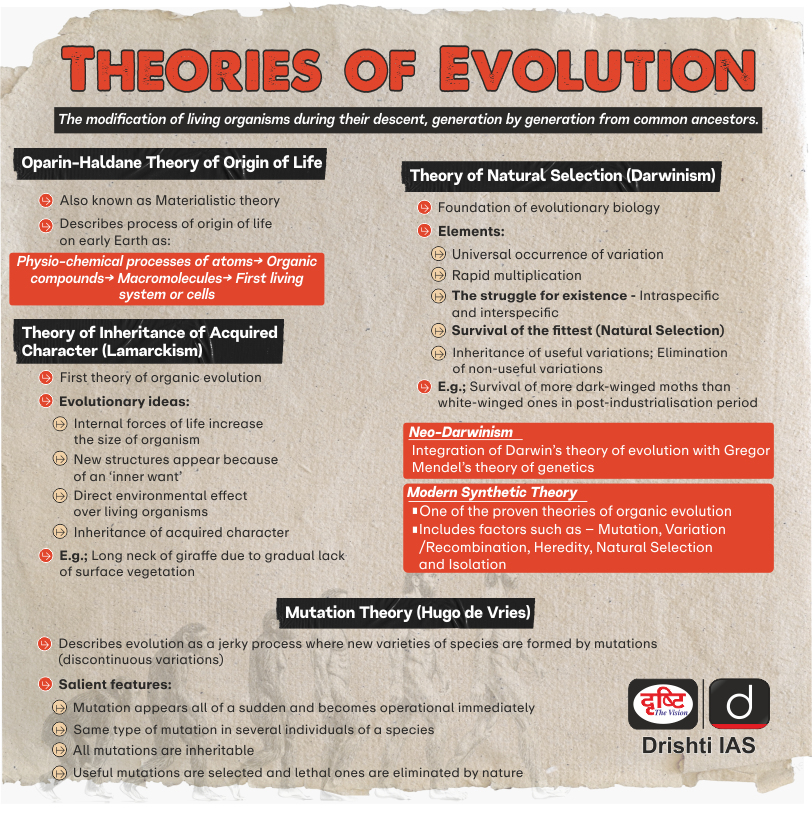Important Facts For Prelims
Last Universal Common Ancestor (LUCA)
- 18 Jul 2024
- 5 min read
Why in News?
Recently, in a new study, scientists have said the last universal common ancestor (LUCA) could have formed just 300 million years after the earth formed.
What are the Recent Key Highlights of the Research?
- About:
- Researchers believe all three branches of life namely bacteria, archaea, and eukarya originated from a single cell, called the last universal common ancestor (LUCA).
- LUCA had a small genome with about 2.5 million bases and 2,600 proteins, sufficient for survival in its unique environment.
- LUCA's metabolites might have created a secondary ecosystem for other microbes to emerge, and it possibly had immunity genes to fight off viruses.
- Though there is no fossil evidence to support the existence of LUCA, modern genomes share so many features that provide some insights.
- However, the theory of the molecular clock allowed scientists to reconstruct the ‘tree of life’.
- As per theory, the rate at which mutations are added or removed from a population’s genome is proportional to the rate of acquiring new mutations, which is constant.
- The mutation rate varies between species.
- Based on the findings, researchers created a method to estimate the time between evolutionary events by using known mutation rates and linking genomes to specific events like the evolution of the first mammal or the age of fossils as benchmarks.
- As per theory, the rate at which mutations are added or removed from a population’s genome is proportional to the rate of acquiring new mutations, which is constant.
- Based on the earlier findings of fossils in the Pilbara Craton in Australia, the earliest life forms were believed to be date back to 3.4 billion years ago.
- Significance of Findings:
- Overall, these findings are crucial for understanding how life began and evolved on Earth and for seeking similar life forms elsewhere in the universe.
- These evolutionary insights will boost efforts to engineer synthetic organisms for various processes on Earth and to create or manage ecosystems on other planets in the future.
What are Various Competing Theories of Life's Origin?
- Oparin-Haldane Hypothesis: In 1924 and 1929, Oparin and Haldane respectively suggested the first molecules making up the earliest life forms gradually self-organised from a “primordial soup” in a young earth’s tempestuous, prebiotic environment. This idea is today called the Oparin-Haldane hypothesis.
- Miller-Urey Experiment: It showed that in the right conditions, inorganic compounds could give rise to complex organic compounds.
- Under it methane, ammonia, and water were mixed and applied an electric current to produce amino acids, the building blocks of proteins.
- Panspermia Hypothesis: It suggests that meteorites could have brought life's building blocks to Earth, supported by discoveries of extraterrestrial organic material and amino acids on asteroids.
Read More: Earth’s Mantle and Evolution of Life
UPSC Civil Services Examination, Previous Year Question (PYQ)
Prelims:
Q. Consider the following: (2013)
- Electromagnetic radiation
- Geothermal energy
- Gravitational force
- Plate movements
- Rotation of the earth
- Revolution of the earth
Which of the above are responsible for bringing dynamic changes on the surface of the earth?
(a) 1, 2, 3 and 4 only
(b) 1, 3, 5 and 6 only
(c) 2, 4, 5 and 6 only
(d) 1, 2, 3, 4, 5 and 6
Ans: (d)
Q. Which one of the following sets of elements was primarily responsible for the origin of life on the Earth? (2012)
(a) Hydrogen, Oxygen, Sodium
(b) Carbon, Hydrogen, Nitrogen
(c) Oxygen, Calcium, Phosphorus
(d) Carbon, Hydrogen, Potassium
Ans: (b)







